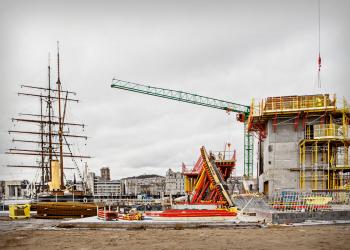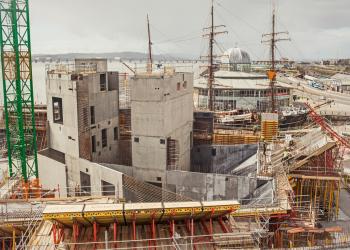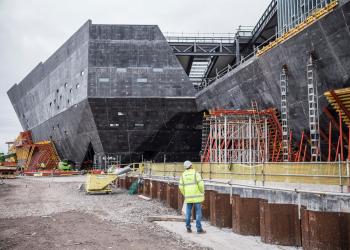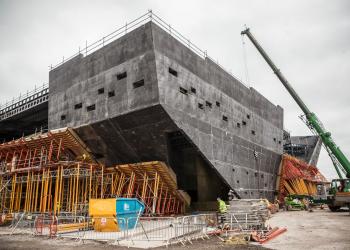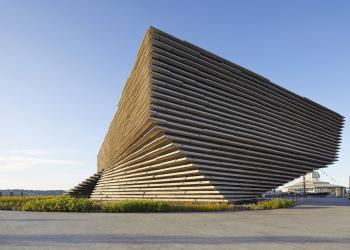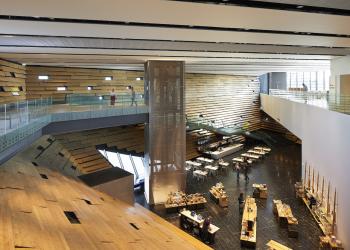Designing and operating an environmentally conscious and sustainable museum for the 21st century.
As Scotland’s design museum, tasked with showcasing the very best of design and creativity from around the world, the environmental credentials for V&A Dundee were a major part of the building’s design

V&A Dundee
Go To WebsiteAddressed Challenges:
- Health & Wellbeing
- Tech & innovation
- Carbon emissions
- Excessive consumption
Action Areas:
- Built Environment
- Energy
Initiative Purpose:
Mitigation
The Story
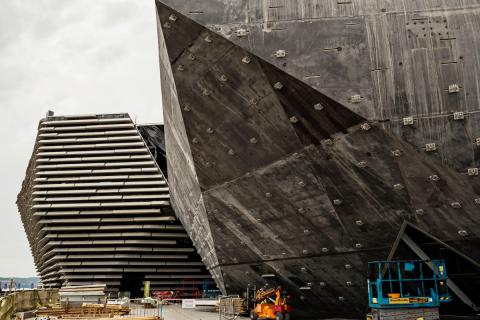
V&A Dundee presents the brilliance of Scottish creativity and the best of design from around the world. The first ever dedicated design museum in Scotland and the only other V&A museum anywhere in the world outside London, V&A Dundee provides a place of inspiration, discovery and learning through its mission to enrich lives through design. Created through a ground-breaking partnership between the Victoria and Albert Museum in London, Dundee City Council, Scottish Enterprise and the universities of Dundee and Abertay, the museum opened its doors in September 2018. As a key part of the city’s regeneration, as well as a landmark museum for the 21 century, the design brief required the building’s energy systems to have the highest level of energy efficiency and innovation.
In 2011, during the initial design phases, a Low and Zero Carbon Technologies study was undertaken to identify the most appropriate form of renewable energy for the museum. Renewable energy options were analysed including wind turbines, solar panels, photovoltaic cells, biomass and river source heat pumps. A ground source heat pump – supplemented with air source heat pumps on the roof – was identified as the most energy efficient option to provide heating and cooling to the building. An additional benefit was that such a method would have no adverse aesthetic impact on the museum’s exterior. In total, 30 boreholes – each with a depth of 200 metres – use the latent heat from the ground to provide a stable supply of heat to the building during colder weather.
The system is designed to operate in reverse during the summer to cool the building and recharge the boreholes. V&A Dundee is primarily constructed using reinforced concrete which has a high thermal mass, meaning it retains heat and releases it slowly, helping to avoid large temperature fluctuations in the museum. Underfloor heating is also an effective way of keeping the building at a more stable temperature, while natural ventilation is used to reduce the need for complex mechanised systems to circulate air. The whole system is continuously monitored and controlled by the Building Management System (BMS) building manager and systems are adjusted automatically as required, based on internal and external conditions. For example, when the COVID-19 pandemic restricted people from using buildings normally, the BMS increased the fresh air intake by the air handling units to optimise the air quality. In addition, the BMS carefully monitors the environmental conditions in the galleries, an essential requirement for a museum which contains objects that are incredibly sensitive to fluctuations in light, temperature of humidity. Sustainability doesn’t stop at the physical building; it extends to our programmes and working practices through reusing materials, minimising waste and using local suppliers where possible. Partnerships with external organisations and participation in events such as Green Health Week also help to highlight much of this ongoing work. Lastly, the core inspiration for the design of the museum is based on a connection with and awareness of the natural world.
Success & Outcomes
Due to the combined technologies and systems installed during its design and construction, the building is performing to a very high standard. The combined ground and air source heat pumps provide direct renewable energy for V&A Dundee, with 800,000 kWh/annum of heating and 500,000 kWh/annum of cooling. Combined with the sun pipes and LED lighting, this is reducing the electrical load of the building by approximately two thirds compared to a similar building of this size and type. A key measure of this success was the museum achieving the BREEAM Excellent category as a recognised measure of sustainability. Visitors can see the energy performance of the museum for themselves, displayed in real time on a screen next to the main entrance.
Advice for others looking to do something similar
Explore a broad range of strategies that may suit the project, considering the technologies currently available, the cost of implementing them, anticipated maintenance, the expected environmental savings and the lifespan of the project, over which time, savings – both environmental and financial – will be made. Integrate ongoing monitoring to ensure the systems are working as expected.
Employ an architect with experience of developing similar sustainable projects. Part of their remit should be identifying the environmental challenges and opportunities of any given site, and exploring ways to use the natural resources available to the building’s advantage.
Consider wiring a sustainability policy for the project that goes beyond the design and construction of the building to its sustainable operation, sustainable sourcing and procurement policy.
